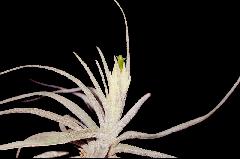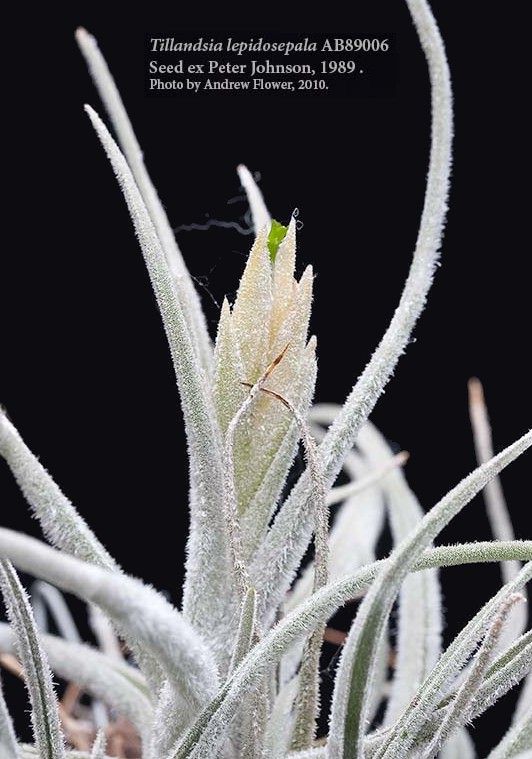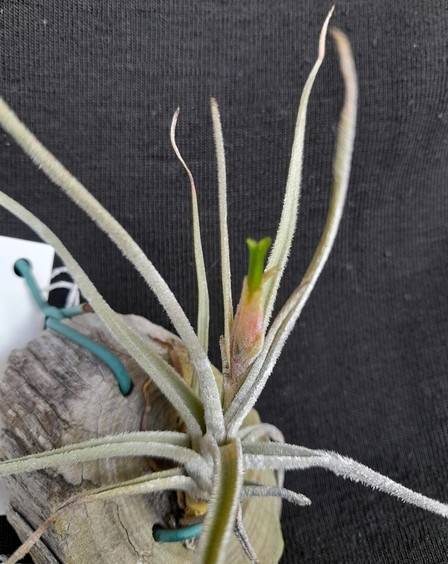


Detail from Ehlers in Die Brom Sonderheft 6: 113-116. 2009
Plant stemless or having a very short stem, grows often in large groups or dense clumps, flowering up to 15 cm high. The few leaves form an erect to spreading lax, irregular rosette, up to 18 cm diameter.
Leaves up to 16 cm long, fairly succulent, covered with somewhat spreading grey scales; sheaths l0-15 mm long, to 15 mm wide, oval or almost round, somewhat (arched) inflated, scaled, base glabrous.
Blades above the sheath 7 mm wide, up to 15 cm long, linear-triangular acuminate, erect or spreading, with margins bent inward, and with spreading dense silver-grey scales.
Inflorescence exceeded by the leaves,
peduncle is rather short, thin, hidden in the rosette,
peduncle bracts few, are erect, dense tile-like (imbricate), similar to the leaves and roughly as long as the inflorescence.
The fertile part of the inflorescence is simple or more rarely with a small additional second spike, in this case the primary bract is similar to the upper peduncle bracts;
spikes 3-5 cm long, (1-)1.2-1.8(-2) cm wide, dense distichous, compressed, complanate, but flattened on the side, with 2-5 sessile flowers.
Floral bracts 20-35 mm long, 6-9 mm wide, exceeding the sepals, 3-4 times as long as the space between the flowers (internodes), narrow-oval, acuminate, acute, almost membranaceous, not carinate, green, dense grey scales.
Sepals 12-20 mm long, 4-5 mm wide, lanceolate acuminate, free, strongly nerved, green, dense grey scaled, the adaxial carinate.
Petals 2-2.5 cm long, 2.5-3.5 mm wide, with rounded tips, forming an erect tube, the tips are not bent outwards, #82 mossgreen or #83 fern-green (Isley III., P. T. 1987, colour chart).
Stamens and pistil enclosed in the flower, filaments 15-18 mm long, thin thread-like, white, anthers 2.5-3 mm long, yellow-olive, style 8-10 mm long, yellow,
stigma small, the green stigma lobes somewhat spreading.
Ovary 5 mm high, 3,5 mm in diameter.
Seed capsule cylindrical, 3 cm long.
Species name: The name refers to the scales on the sepals.
Habitat and range: Northern Mexico in the states of Aguascalientes, Guanajuato, Hidalgo, Jalisco, Mexico, Michoacan, Puebla, Queretaro and Zacatecas.
The species grows almost always as an epiphyte, usually in large groups.
Cultivation: This species is a bit delicate in culture. In winter it should be kept not too moist. In summer Tillandsia lepidosepala can be cultivated outside.
It may be confused with Tillandsia tortilis, with which it has a great similarity in habit. The differences between the two species are shown in the description of Tillandsia tortilis.
Examined material
Queretaro: Queretaro-S. M. Allende, Marz 1985, Ehlers EM850101 (WU).
Guanajuato: Guanajuato, 2100 m, Ehlers EM850205 (WU); San Jose Iturbide-Tierra Blanca, 2140 m, 16.2.1996, Ehlers EM061601 (WU).
Hidalgo: S. M. Regla, 2000 m, Ehlers EM032208 (WU); Valle los Venados, Ehlers EM8808 (WU); Valle los Venados, 1900 m, 1993, Schindhelm s.n. (WU).
Mexico: Texcoco, 2500 m, 1996, flower in Col. Ehlers, K Wodisch s.n. (WU).
Michoacan: Qiroga -Zacapu, 2200 m, 4.2.2004, Ehlers EM041101 (WU).
Zacatecas: Puente La Tiquata, 2000 m, 11.2.2004, Ehlers EM041803 (WU).
Tillandsia lepidosepala L. B. Smith, Proc. Am. Acad. (Contr. Gray Herb. 106) 70: 155, pI. 2, figs. 2, 3. 1935.
Desc from S&D p928
Plant stemless or very short-caulescent, often aggregated in dense masses.
Leaves rosulate, to 15 cm long, covered with slightly spreading cinereous scales;
Sheaths broadly ovate or suborbicular, not at all inflated, 10-15 mm long;
Blades erect or spreading, linear-triangular, attenuate, 7 mm wide at the base, involute.
Scape short, almost hidden by the leaves;
Scape-bracts erect, densely imbricate, foliaceous, about equaling the inflorescence.
Inflorescence simple and distichous-flowered or rarely with a small second spike and primary bract like the upper scape-bracts, exceeded by the leaves;
Spikes 3-5 cm long, 2-5-fiowered.
Floral bracts lanceolate, acute, 20-35 mm long, equaling or exceeding the sepals, three to four times as long as the internodes, submembranaceous, not at all carinate, densely cinereous-lepidote;
Flowers sessile.
Sepals lanceolate, acuminate, to 20 mm long, strongly nerved, densely lepidote, free, the lateral ones carinate.
Capsule cylindric, short-beaked, about equaling the floral bracts.
Type. Pringle 5323 (holotype GH), Lake Cuitzco, Michoacan, Mexico, 1892.
DISTRIBUTION. Saxicolous and epiphytic, dry slopes, 2000-2450 m alt, central Mexico.
MEXICO. HIDALGO: Tula, Jul 1905, Rose, Painter & Rose 8283 (US); Barranca de Metztitlan, Zoquital to Los Venados, 31 Jul 1948, Moore & Wood 4221 (US); Los Ibes, Tepeapulco, 26 Aug 1963, Rzedowski 16952 (US). PUEBLA: Teocalli de Cholula, Puebla, 7 Nov 1907, Arsene 1846 (US); Malintze, 16 Dec 1910, Nicolas in Arsene 5742 (US). MICHOACAN: Quiroga, 26 Feb 1960, Van Hyning 6014 (US). WITHOUT EXACT LOCALITY: Bourgeau 97 (GH, P); Foster XV (GH).